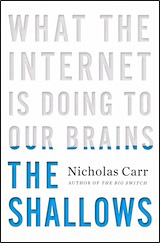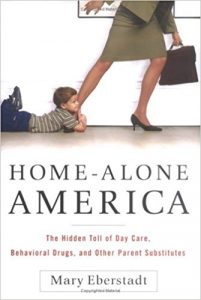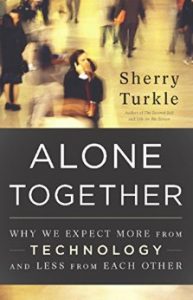Author’s Note: The day after this post went live, Dr. Schore’s article was in large part featured in a New York Times opinion piece by columnist Thomas B. Edsall entitled The Increasing Significance of the Decline of Men. Click on the link you just passed to see how Dr. Schore’s recent work is playing in the popular press. Hopefully you can see that I also try to take Dr. Schore’s work in similar directions in the post below. I also wrote a LinkedIn article that deals with some of the same topics Edsall tackles. That article is entitled Securely Attached: Automation and the New Valued Employee. I’ve linked to the version that appears here at BLT.
— o O o —
If you’re a longtime reader of my BLT blog then you have heard me make the following statement more than once:
An early safe and secure attachment relationship between mother and her infant pours the foundation (if all goes well) upon which rests robust Executive Function (EF) skills such as empathy, appropriately focusing and shifting attention, perspective-taking, and mental time travel.
Why do I include the disclaimer “if all goes well?” Well, there may be organic reasons why the attachment–EF connection does not take firm hold. As an example, attachment researchers have discovered that persons on the autism spectrum could be coded securely attached while at the same time have difficulties with such EF skills as eye contact, empathy, and what cognitive scientists call Theory of Mind (ToM): recognizing that others possess a mind different from our own.
Attachment and neurobiology researcher Allan Schore, whose work we have supported in the past, was kind enough to send me a copy of his 2017 paper entitled All Our Sons: The Developmental Neurobiology and Neuroendocrinology of Boys At Risk. This article appears in Infant Mental Health Journal (vol. 38(1), p. 15–52). Information contained in this article was presented up in Santa Fe at The Psychology of Boys at Risk: Indicators from 0-5 conference that was hosted by the Santa Fe Boys Education Foundation. In this post I’d like to present a few bullet points concerning All Our Sons, and in doing so, talk about what happens when the “if all goes well” doesn’t go so well.
• In my opinion, Dr. Schore does a great job pointing out developmental gender differences in non-threatening ways. Investigation of gender differences of any kind has been taboo since the rise of postmodern sensibilities starting in the 1970s. However, Schore makes it clear that we cannot recognize that boys are at risk for serious developmental issues unless we accept that there are developmental differences between boys and girls.
• According to Dr. Schore’s research, boys are at risk developmentally because, compared to girls, their brains take longer to mature and are subjected to longer windows of vulnerability. As an analogy, girls seem to come into the world wearing sunblock whereas boys have little to no SPF (Sun Protection Factor). As a result, boys are prone to getting “sunburn,” developmentally speaking.
• One source of male sunburn: epigenetic assaults. What the heck is epigenetics? In very simple terms, genes tend to control what is expressed while epigenetics tends to control how the what is expressed. The WhatIsEpigenetics.com web site uses the analogy of movie scripts and movie directors to explain epigenetics. Genes are like movie scripts. Epigenetics is like movie directors. Different directors can interpret the same script differently. As the WhatIsEpigenetics.com web site puts it, “The script can be the same, but the director can choose to eliminate certain scenes or dialogue, altering the movie for better or worse. After all, Steven Spielberg’s finished product would be drastically different than Woody Allen’s for the same movie script, wouldn’t it?” Because boy’s brains mature slowly, and they have longer periods of developmental vulnerability, they are more influenced by epigenetic assaults. What epigenetic assaults? you may ask.
• Dr. Schore points to two main epigenetic assaults: one that most of us can agree on, and another a bit more controversial. The easier one first: environmental toxins. In specific, Schore spends considerable time looking at BPA or Bisphenol A. BPA is used in the “manufacture of plastics and epoxy resins, including food and beverage containers” (quoting Schore). Schore calls BPA a “toxic endocrine-disrupting chemical.” Schore states:
[A] massive body of research now unequivocally has demonstrated that in prenatal and postnatal periods, the sex-specific gonadal steroids androgen (testosterone) and estrogen (estradiol) produced by the hypothalmic-pituitary-gonadal (HPG) axis play an essential organizing role in brain development and in the early evolution of gender-specific differences.
According to the web site LiveScience.com, “The endocrine system is the collection of glands that produce hormones that regulate metabolism, growth and development, tissue function, sexual function, reproduction, sleep, and mood, among other things.” So, what Schore is saying is that if the endocrine system is disrupted in any way early on, say, through exposure to endocrine-disrupting chemicals, then brain function and brain organization are adversely affected. Simply, epigenetic assaults see to it that things do not go so well. As evidence, Schore points to increases in such mental health maladies as ADHD, autism, and even schizophrenia. Boys seem to be hit the hardest as evidenced by increased levels of criminality, conduct disorder, and overall aggression (e.g., externalizing behaviors). Girls, however, do not get through unscathed (even with their natural sunscreen) as evidenced by increased levels of depression and other internalizing behaviors.
• Now on to the more controversial epigenetic assault: daycare. Dr. Schore spends considerable time looking at the evidence that suggests that use of poor quality daycare, or daycare for extended periods of time, can result in epigenetic assaults. Schore mentions work by Jay Belsky in the area of daycare. Dr. Belsky was one of the first researchers to investigate how daycare may affect the development of children. Essentially Belsky suggested that high quality daycare used in moderation (less than 20 hours per week) was OK. In contrast, low quality daycare should be avoided. Sadly, Belsky was crucified for his position. Dr. Belsky talks about this dark period in his career in a 2003 article entitled The Politicized Science of Day Care: A Personal and Professional Odyssey (Family Policy Review, vol. 1, num. 2, p. 23–40). In 1986, Belsky published an article entitled Infant Day Care: A Cause for Concern. As Belsky puts it, this article created a “firestorm of controversy.” “[I] had violated what I have come to regard as the eleventh commandment of the field of child development: ‘Thou shalt not speak ill of day care—in any manner, shape, or form,’ ” reveals Belsky. [1] So, yes, Dr. Schore takes a firm grip of the proverbial third rail of child development: daycare. Schore goes on to suggest that the US should adopt family leave policies not unlike those found in countries like Italy where family leave policies are mandated by the government. For more on family leave and daycare policies in other countries, see Michael Moore’s 2015 movie Where to Invade Next (which I just happened to see last weekend).
• One last bullet point. Dr. Schore makes an observation that fits nicely with the work of green feminist Dr. Jane Caputi. Our Foundation supported Dr. Caputi’s 2015 video entitled Feed the Green: Feminist Voices for the Earth. Both Schore and Caputi make observations along the lines of how poor people and people of color often shoulder the burden of toxic waste. New Mexico—a very poor state—is home to WIPP or the Waste Isolation Pilot Plant, where nuclear waste is buried. Quoting an international group of authors (writing in a 2015 issue of International Journal of Gynecology and Obstetrics), Schore states, “Exposure to toxic environmental chemicals and related health outcomes are inequitably distributed within and between countries; universally, the consequences of exposure are disproportionately borne by people with low incomes….” Along these lines, in 2015, the EPA played a role in accidentally rupturing the Colorado Gold King Mine and spilling millions of gallons of toxic waste (i.e., high concentrations of heavy metals such as arsenic, mercury and lead) into the Animas River affecting three states Colorado, New Mexico, and Utah. Many tribes were affected by this toxic spill. To date, the EPA has provided little assistance for cleanup efforts. New Mexico Attorney General Hector Balderas has filed a lawsuit against the EPA seeking funds for cleanup efforts.
I’ll leave it here. The main point to keep in mind is that epigenetic assaults can inhibit the proper growth and organization of brain centers in such a way that it is difficult for an infant/child to engage in social (e.g., attachment) interactions with his or her mother. These difficulties then make it hard for a safe and secure attachment relationship to develop between mother and infant/child, which then feeds back into brain growth and organization. In essence, a vicious cycle gets set up that is hard to break. I invite you to read Dr. Schore’s article in its entirety.
I’d be remiss if I did not point out that John Bowlby and his colleagues railed against the epigenetic assault of evacuation policies during WWII. UK policy forced families to evacuate children from the cities to the countryside, often to strangers. Bowlby saw this as an assault that could have long term detrimental consequences. The ravages of war have not gone away. Just the other day I viewed a slide show by CNN entitled Cost of War on Syrian Children’s Mental Health. This slide show profiles a new report by Save the Children. According to this report, “3 million children under the age of six in Syria know nothing but war.” These kids are experiencing “loss of family and friends” and “near constant insecurity.” These children are engaging in such behaviors as “bed wetting, self-harm and suicide attempts.” The Save the Children report concludes thus: “Toxic stress could have a life-long impact on children’s health.” Dr. Schore’s work shows us why this is so.
My only comment: I was disappointed that Dr. Schore did not at least mention other forms of epigenetic assaults beyond environmental toxins and daycare. Daycare is but one form of parent substitute in wide use today. Here are the parent substitutes that social critics, such as Mary Eberstadt [2] and Sherry Turkle (mentioned below), point to:
- Daycare
- Behavioral Drugs (such as the stimulants Ritalin and Adderall)
- Inappropriate sex
- Violent music
- Food
- Drugs and alcohol
- Digital and screen devices
- Social media (such as Facebook and Twitter)
- Specialty boarding schools
In what can only be called “fear mongering,” I would suggest that feeding children as young as two-and-a-half years old behavioral drugs more potent than cocaine will ultimately prove to be one of the worst forms of epigenetic assault. The effects of long-term use of legal stimulant drugs is still being investigated.
At a conference up in Calgary back in 2005, Sir Richard Bowlby, John’s son, mentioned a long list of risk factors that can act against the formation of safe and secure attachment. [3] Here are the risk factors that Sir Richard [4] gave us:
- drug and alcohol abuse
- mental illness
- poverty
- criminality
- neglect
- mental, physical, or sexual abuse
- parental rows (fights)
- family breakdown
- low education
- unwanted pregnancy
- unsupported parent under the age of 18
- insensitive parenting
- homelessness and neither parent employed
Sir Richard gave us this “bottom line” by stating: “Children receiving inappropriate daycare combined with insecure attachment, start life with two risk factors.” According to Sir Richard’s research, two or more risk factors are associated with increased levels of insecure attachment. I would add two more items to the above list: digital devices and behavioral drugs (mentioned above). Digital devices are now sucking up attention at alarming rates. [5] For more on this topic, I would recommend two books:
- The Shallows—What the Internet is Doing to Our Brains by Nicholas Carr (2010)
- Alone Together—Why We Expect More from Technology and Less From Each Other by Sherry Turkle (2011)
In the same way Naomi Klein, in her 2014 book entitled This Changes Everything: Capitalism vs. The Climate, describes how farmers and indigenous peoples are now coming together to fight pipelines, maybe we’ll see neurobiologists and green feminists coming together to save the environment. Maybe we’ll see a Save Our Environments, Save Our Brains conference. Hmmm … not a bad idea … a place where philanthropists could definitely lend a hand.
Notes:
[1] John Bowlby also received a lot of flak because his work was viewed (unfairly) as supporting an anti-daycare stance. Sir Richard Bowlby, John’s son, writes the following in the 2004 book entitled Fifty Years of Attachment Theory (London: Karnac): “For some years I have been presenting recollections of my father’s professional struggle to develop Attachment Theory, and some of the public’s misunderstandings of what he wrote. Sometimes this has been because of the emotional difficulties that they have with his work, and there are also wider social issues which still prevent many people from accepting Attachment Theory.”
[2] See Mary Eberstadt’s 2004 book entitled Home-Alone America—The Hidden Toll of Day Care, Behavioral Drugs, and Other Parent Substitutes (New York: Sentinel).
[3] Dr. Schore was kind enough to review my post. He asked that I include this observation: “On your list of attachment and ACE risk factors, in the fetal and postnatal periods boys would be more neurobiologically vulnerable to all the listed stressors.” See, boys do not come with sunscreen.
[4] Sir Richard’s risk factors go along with what are known as Adverse Childhood Experiences (ACEs). ACEs include:
- Physical abuse
- Sexual abuse
- Emotional abuse
- Physical neglect
- Emotional neglect
- Mother treated violently
- Substance misuse within household
- Household mental illness
- Parental separation or divorce
- Incarcerated household member
The Ace Project was brought about by a partnership between the Center for Disease Control (CDC) and Kaiser Permanente.
[5] The other day I viewed an article over at Yahoo Finance that talks about how married couples are having less sex. Apparently a new study in the journal Archives of Sexual Behavior suggests that sexual activity is dropping off because married couples are “too busy doing other things, like sending work emails or playing games on their phone” (quoting the Yahoo Finance article). If digital devices are keeping married couples apart, it follows that they are keeping parents away from their kids as well.







